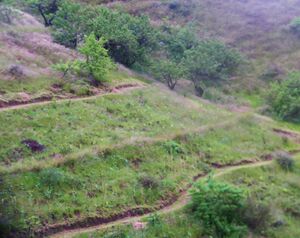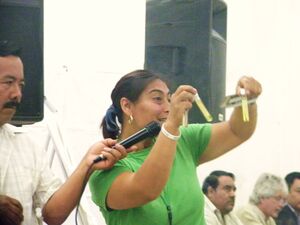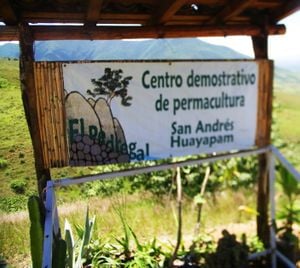
This page is the beginnings of a portal for Mexico community action in response to Ecological emergency.
Biodiversity[edit | edit source]
Mexico ranks fourth in the world in biodiversity and is one of the 17 megadiverse countries. With over 200,000 different species, Mexico is home of 10–12% of the world's biodiversity. Mexico ranks first in biodiversity in reptiles with 707 known species, second in mammals with 438 species, fourth in amphibians with 290 species, and fourth in flora, with 26,000 different species. Mexico is also considered the second country in the world in ecosystems and fourth in overall species. About 2,500 species are protected by Mexican legislation. In 2002, Mexico had the second fastest rate of deforestation in the world, second only to Brazil. It had a 2019 Forest Landscape Integrity Index mean score of 6.82/10, ranking it 63rd globally out of 172 countries. According to SGI there is Deforestation and soil erosion especially in rural areas of Mexico. In the 2022 report it was noted environmental protection laws have improved in major cities but remain unenforced or unregulated in rural regions.
In Mexico, 170,000 square kilometers (65,637 sq mi) are considered "Protected Natural Areas". These include 34 biosphere reserves (unaltered ecosystems), 67 national parks, 4 natural monuments (protected in perpetuity for their aesthetic, scientific or historical value), 26 areas of protected flora and fauna, 4 areas for natural resource protection (conservation of soil, hydrological basins, and forests) and 17 sanctuaries (zones rich in diverse species). Plants indigenous to Mexico are grown in many parts of the world and integrated into their national cuisines. Some of Mexico's native culinary ingredients include maize, tomato, beans, squash, chocolate, vanilla, avocado, guava, chayote, epazote, camote, jícama, nopal, zucchini, tejocote, huitlacoche, sapote, mamey sapote, and a great variety of chiles, such as the habanero and the jalapeño. Most of these names come from the indigenous language of Nahuatl. Tequila, the distilled alcoholic drink made from cultivated agave cacti is a major industry. Because of its high biodiversity Mexico has also been a frequent site of bioprospecting by international research bodies. The first highly successful instance was the discovery in 1947 of the tuber "Barbasco" (Dioscorea composita) which has a high content of diosgenin, revolutionizing the production of synthetic hormones in the 1950s and 1960s and eventually leading to the invention of combined oral contraceptive pills. W
Rewilding[edit | edit source]
The Rewilding Institute is an organization concerned with the integration of traditional wildlife and wildlands conservation to advance landscape-scale conservation. It was founded by environmental activist Dave Foreman.
The Rewilding Institute's mission is to work toward the survival and flourishing of large carnivores in North America by promoting the establishment of suitable habitats in the wilderness, which are permanently interconnected as to allow their natural movement. They believe that humans and large carnivores can and should co-exist in North America. They wish to undo the damage done by over-hunting, over-logging, and exploitation of natural resources. Through continent-scale conservation efforts, they hope to prevent further extinctions of large predators, and to restore them to their function of maintaining the ecological balance of animal life in the wild. They have proposed reestablishing wild populations of wolves in interconnected, protected habitats, so that they can resume their ecological role. As part of their program, they have worked to get wildlife crossings included in interstate highway projects. W
- Rewilding Earth, home of the Rewilding Institute
Environment quality activism[edit | edit source]

The Oaxaca Water Quality Forum (called Foro Oaxaqueño del Agua in spanish) is a meeting that brings together concerned members of the public, nonprofits, and government officials to discuss water quality issues and possible solutions in Oaxaca, Mexico.
Water supply and sanitation in Mexico is characterized by achievements and challenges. Among the achievements is a significant increase in access to piped water supply in urban areas (88% to 93%) as well as in rural areas (50% to 74%) between 1990 and 2010. Additionally, a strong nationwide increase in access to improved sanitation (64% to 85%) was observed in the same period. Other achievements include the existence of a functioning national system to finance water and sanitation infrastructure with a National Water Commission as its apex institution; and the existence of a few well-performing utilities such as Aguas y Drenaje de Monterrey.
The challenges include water scarcity in the northern and central parts of the country; inadequate water service quality (drinking water quality; 55% of Mexicans receiving water only intermittently according to results of the 2000 census); poor technical and commercial efficiency of most utilities (with an average level of non-revenue water of 51% in 2003); an insufficient share of wastewater receiving treatment (36% in 2006); and still inadequate access in rural areas. In addition to on-going investments to expand access, the government has embarked on a large investment program to improve wastewater treatment.
see also: Water scarcity in Mexico W
Fundación Cántaro Azul
Fundación Cántaro Azul is a non-profit organization operating of Chiapas, Mexico that takes a multi-disciplinary approach to providing people throughout Mexico with access to clean water, sanitation, and hygienic practices. Fundación Cántaro Azul (FCA) undergoes a wide range of activities in order to achieve its goal. The organization primarily creates and provides communities with water sanitation and hygienic technologies, like home water sanitation, that ensure households and communities with good water quality and other public health benefits. Accompanying these activities, FCA conducts research to assess quality at project locations. Also, they champion education programs that promote good hygiene practices. They work closely with communities, as well as local health services, governments, and organizations, to ensure that each project is tailored to fit that community's needs. W
Mexico's environmental challenges
Mexico faces significant environmental challenges damaging nearly all sections of the country. Vast expanses of southern and southeastern tropical forests have been denuded due to mineral resource extraction, and then, far behind in second place, for cattle-raising and agriculture. For example, tropical forests covered almost half of the state of Tabasco in 1940 but less than 10% by the late 1980s. During the same period, pastureland increased from 20 to 60% of the state's total area. Analysts reported similar conditions in other tropical sections of Mexico. Deforestation and desertification has contributed to serious levels of soil erosion nationwide. In 1985 the government classified almost 17% of all land as totally eroded, 31% in an accelerated state of erosion, and 38% demonstrating signs of incipient erosion. Mexico has developed a Biodiversity Action Plan to address issues of endangered species and habitats that merit protection.
Soil destruction is particularly pronounced in the north and northwest, with more than 60% of land considered in a total or accelerated state of erosion. Fragile because of its semiarid and arid character, the soil of the region has become increasingly damaged through excessive cattle-raising and irrigation with waters containing high levels of salinity. The result is a mounting problem of desertification throughout the region. W
Droughts
Considering most of the Country experiences arid and/or semi-arid conditions, droughts are one of the most common natural disasters in Mexico. Droughts happen when there are low levels of rainfall in a certain area. As a result, droughts significantly impact agricultural production systems that many people all over the world depend on. Droughts are also impacted by high temperatures that dry up pieces of land. Droughts are very common in all of North America and they have 5 levels of intensity. Regions of Mexico which most commonly experience drought-like conditions range from Veracruz, Tabasco, and the Yucatán. In May 2016, 14.3% of land surface area in Mexico experienced dramatic shift in drought levels from moderate to extreme. The month of November is primarily known as the time of year when the wet season ends and the dry season begins. However, in November 2016, regions in the Yucatán peninsula and Tabasco actually had non-stop drought with the previous dry season, regarding it as the 40th driest month ever. W
Trees, woodland and forest[edit | edit source]

Forests help stabilize soil, prevent erosion into water ways, and slows water flow from rain so that there is increased time for percolation into aquifers as well as offering many other ecosystem services. To regenerate ecosystems it is useful imitate nature: plant native plants - not only trees but also shrubs and herbs - and to encourage natural regeneration in places that are not too damaged. In other highly deteriorated areas Pedregal starts by stabilizing the soil before planting any tree. The reforestation plan includes how to care for the plants as well as how to irrigate them when planting. This is one project in a series of soil conservation, groundwater recharge, and farming demonstration projects at Pedregal a Permaculture Demonstration Center in San Andres Huayapam, Mexico.
Mexico had a 2018 Forest Landscape Integrity Index mean score of 6.82/10, ranking it 63rd globally out of 172 countries. W
Wetlands in Mexico[edit | edit source]
There are approximately 70 lakes in Mexico, covering a total area of 3,700 square kilometers (910,000 acres). Some of these lakes, especially in the eastern side, have a volcanic origin and count with numerous endemic species. Lake Chapala, the largest Mexican lake, is considered a hydrological priority region for biodiversity conservation due to its 39 local species, 19 of which are endemic. Lake Catemaco, located in Veracruz, has 12 native species 9 of which are endemic.
Wetlands in Mexico are dynamic, complex and productive ecosystems. Six major wetland are registered in the Ramsar Convention on Wetlands: Lagartos River (Yucatan Peninsula), Cuatrocienagas (Coahuila), La Encrucijada (Chiapas), Marsh Nayarit and Sinaloa, Centla Swamp (Tabasco), and the Colorado River (Baja California).
Cenotes, sinkholes on the Yucatan peninsula that are filled with groundwater, host a number of unique species from bacteria, algae and protozoa (i.e. copepoda, cladocera and rotifera) to vertebrates (i.e.lepisosteus). Cenotes are the main water source for many ancient and contemporary Maya people, as there are no rivers and very few lakes on the peninsula. W
Coastal community activism[edit | edit source]
Mexico's coastal environmental challenges
Mexico's vast coastline faces a series of environmental problems. For example, inadequately regulated petroleum exploitation in the Coatzacoalcos-Minatitlán zone in the Gulf of Mexico has caused serious damage to the waters and fisheries of Río Coatzacoalcos. The deadly explosion that racked a working-class neighborhood in Guadalajara in April 1992 serves as an appropriate symbol of environmental damage in Mexico. More than 1,000 barrels (160 m3) of gasoline seeped from a corroded Mexican Petroleum (Petróleos Mexicanos—Pemex) pipeline into the municipal sewer system, where it combined with gases and industrial residuals to produce a massive explosion that killed 190 persons and injured nearly 1,500 others. W
News and comment[edit | edit source]
2021
Biodiversity: The tale of the 'un-extinct' fish, Dec 29[1]
2019
Agave Power: How a Revolutionary Agroforestry and Grazing System in Mexico Can Help Reverse Global Warming, Dec 18...[2]Climate change solutions news
Citizens rally to protect natural area in Mexico. Peña Colorada serves as a comprehensive regulator of the metropolitan area of Querétaro, Sep 3. Elvira Herrera & Alexis Faber[3]
2016
A proposal to daylight and restore all 45 of Mexico City's urban rivers, Jul 15[4]
See also[edit | edit source]
- Topic overview: Ecological restoration, Community action on biodiversity, Rewilding, Environment quality activism, Trees, woodland and forest, Wetlands, Coastal community activism
- Ecosystem restoration
- UN Decade on Ecosystem Restoration
References